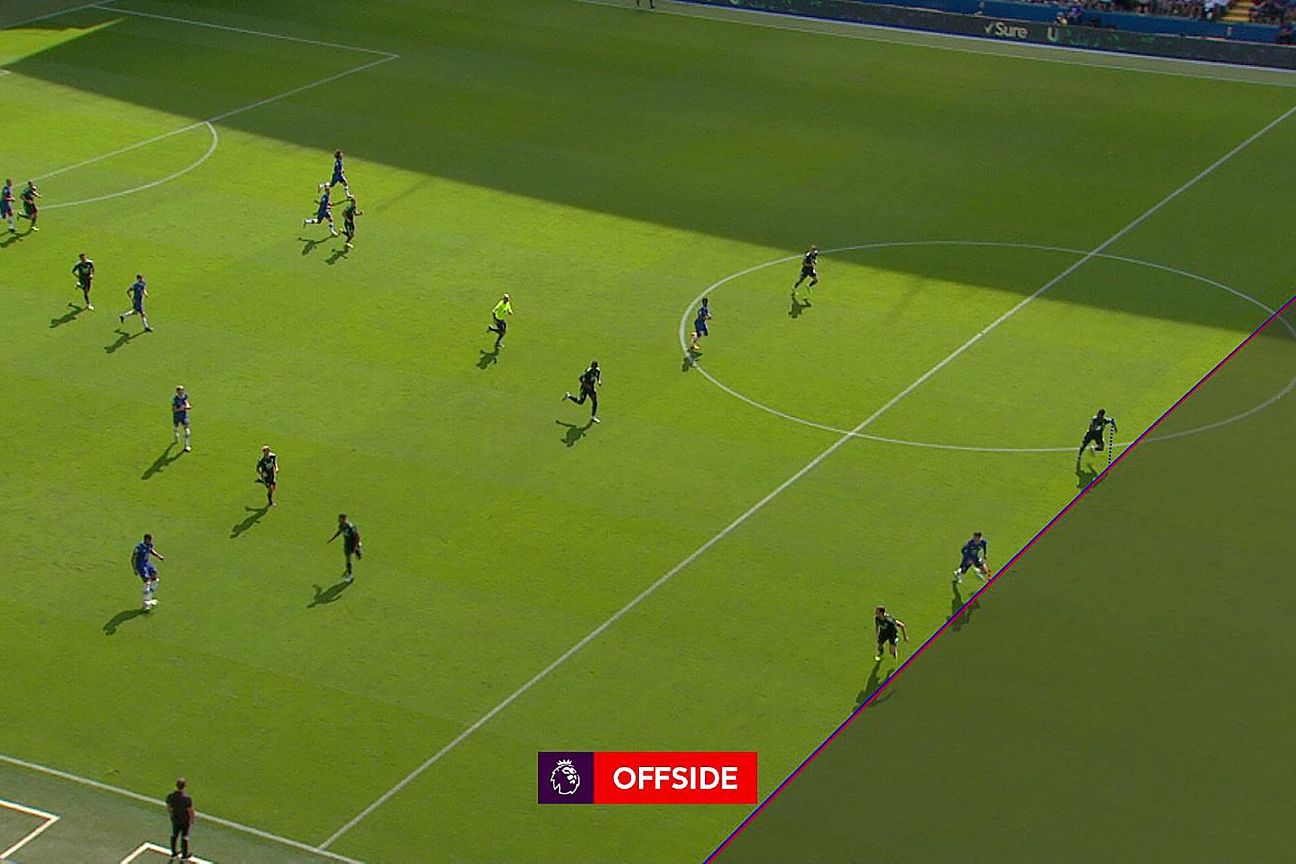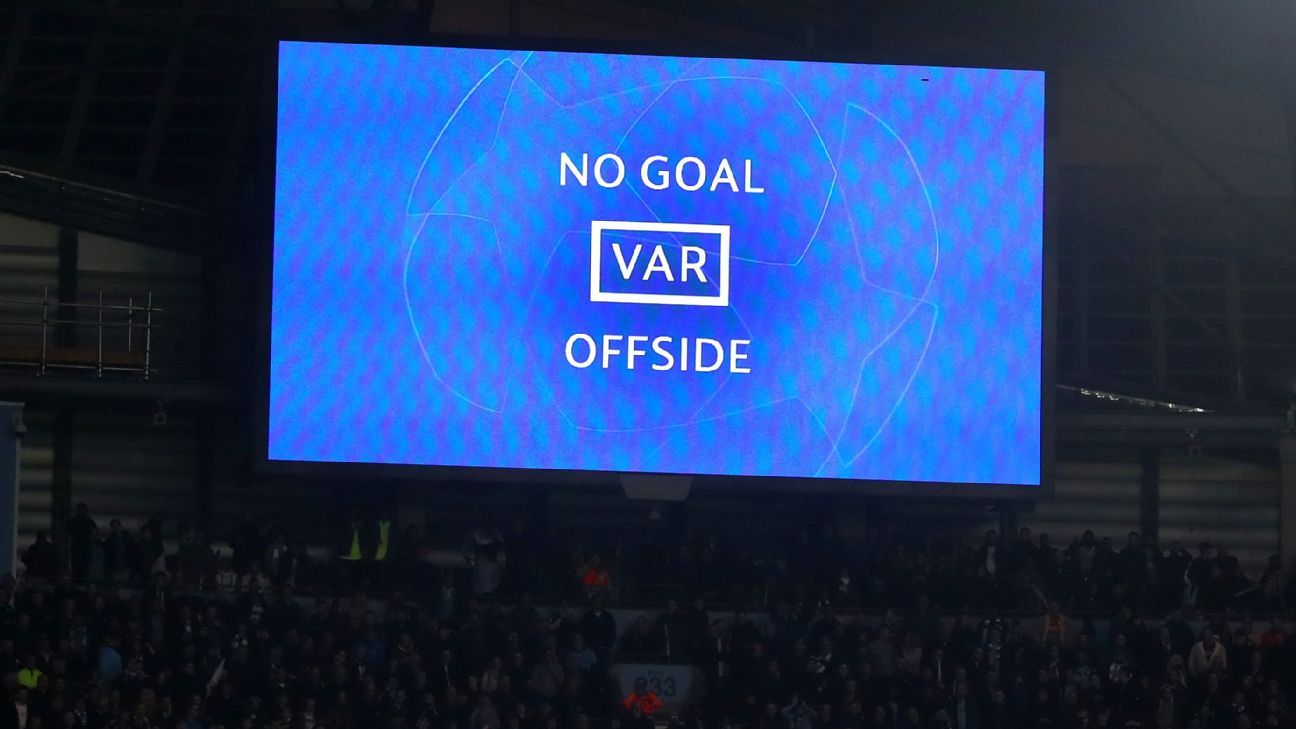FIFA and UEFA have spent the past three years testing out a new artificial-intelligence-based semi-automated offside technology (SAOT), and now it’s ready to be rolled out in the Champions League.
Although SAOT was used by FIFA at the Club World Cup in February, and also by UEFA in the Super Cup between Real Madrid and Eintracht Frankfurt in Helsinki last month, most fans wouldn’t even have noticed it was there. You could say that’s the perfect outcome, but until we regularly see the new technology is changing offside decisions we’re in the dark as to its effectiveness.
– Stream on ESPN+: LaLiga, Bundesliga, MLS, more (U.S.)
The two governing bodies are very confident. FIFA had already approved its use at the World Cup in Qatar, which kicks off on Nov. 20; then unexpectedly UEFA also announced it would start using SAOT for all matches in the Champions League group stage.
The two systems aren’t quite identical, though the overall ethos of using AI to produce the offside result is the same.
“For the good of the game and the good of refereeing, UEFA always wants to use the best technology available,” said Roberto Rosetti, UEFA’s chief refereeing officer. “UEFA is always looking for new technological solutions to improve the game and support the work of the referees. And this is what we want from semi-automated offside in the future.”
So the curtain has now been pulled back and we know a lot more about a flagship development for the VAR project. So how will it work, what are the good points and where will fans still be left feeling frustrated?
– Champions League group stage fixture schedule
Why does VAR offside need to change?
Long delays, perceived inaccuracies and a lack of confidence in the system among fans, players and coaches. And that’s just for starters.
Scepticism also comes from the poor visualisation of decisions, with lines placed on the pitch which cannot replace a person’s own perspective of an offside decision on a camera angle. A player may look onside, but the technology says they are offside.

So, what problems did FIFA and UEFA hope to solve?
Firstly, selecting the exact point the ball is touched by the passer cannot be determined accurately because of the frame rate of TV cameras (50 frames per second) used across all major leagues.
Secondly, the VAR manually selects the furthest forward point on both defender and attacker, which cannot be applied consistently.
AI removes all subjectivity from these two parts of the process, meaning there is no human role.
Added to this, the time taken to judge offside, in some cases up to five minutes for complex decisions, adds further frustration.
All in all, supporters don’t really trust the process as it works now.
“Why is this important for VAR? Offside decisions have a significant impact on the average VAR review time,” Rosetti said. “To identify the correct line position working on a two-dimensional image is very complex. With semi-automated offside we will save time.”
So what is semi-automated offside technology?
SAOT automates the process outlined above and produces a result within seconds. The semi-automated part comes in because the VAR still has to validate the offside decision — the technology cannot tell if an attacker is actively involved in play or confirm the ball was touched by a teammate of that player.
“The system was tested in more than 180 matches in last season’s major UEFA competitions,” Rosetti explained. “The system is ready to be used live and officially from the group stage of the UEFA Champions League. We are very proud to be the first ones to introduce this new technology in a major competition. This innovative system will allow VAR teams to determine offside situations quickly and more accurately, enhancing the flow of the game and the consistency of the decisions.
“The system dramatically improves the accuracy and speed to identify a geographical offside position.”
FIFA believes it will be faster and more accurate.
“In terms of accuracy, it is important because when you are more accurate it’s good,” said Pierluigi Collina, the chairman of the FIFA referees’ committee. “In terms of time, I think it’s more psychological. We felt something was needed, and that’s why we wanted to offer something giving a quicker answer. We are aware that football is different [from other sports] and making a decision faster was important, and that’s why we worked in this direction.”
How will it work?
FIFA and UEFA have devised slightly different systems, but let’s start with the similarities.
Both have 10 (UCL) or 12 (World Cup) bespoke cameras installed under the roof of the stadium at all 32 Champions League grounds and the eight venues staging World Cup matches. These cameras provide optimal tracking for all 22 players, recording 29 data points on all limbs and extremities that are relevant for an offside decision — including the upper arm, toes, knees and head — so the system knows the exact position of a player at any given moment.
All player and ball data is processed in real time by AI, which triggers an alert to the VAR when an offside has been detected. The VAR must then validate that the kick point and offside line are accurate, and the offside player is active, and then inform the referee who can confirm the decision.
This is where things get slightly different.
FIFA has devised a system which uses a sensor inside the World Cup match ball, the Adidas “Al Rihla,” to drastically improve the accuracy of the kick point.
“We will implement in each World Cup stadium, 12 dedicated optical tracking cameras,” said Johannes Holzmuller, FIFA’s director of football technology and innovation. “All these cameras are working together, and 100% synchronised. In addition to that, the official match ball will have a connected ball technology. A 500 hertz IMU [inertial measurement unit] sensor in the centre of the ball.
“This information is transmitted via antennas inside the stadium to the video operations room. In order that the system can detect precisely the offside position, the optical tracking system is collecting 29 data points, and this will happen 50 times per second.
“The IMU sensor inside the ball will provide a ball data stream than is nothing more than the acceleration data of the ball in multiple axis. We will get an automated detection of a very accurate kick point, which is especially important in very close and very tight offside situations.
“We are combining the different data sets by applying Artificial Intelligence, and this automated alert is then appearing on a timeline inside the video operations room. This is happening immediately, within a few seconds. But then of course in addition there’s the manual validation process by the video match officials to make sure that the data and everything is correct.”

But UEFA will have no sensor inside the ball or on the players but the AI will compensate for this.
The optical tracking system tracks the players but also the ball during the entire match. It works at 50fps (1 frame every 0.02 seconds), the same as the offside tech we see in the domestic leagues, but UEFA says it is able to identify any change of direction of the ball.
Between the frames the AI is able to interpolate both the player and ball movements with the system providing a continuous flow of data.
It remains to be seen if UEFA’s system is as accurate as FIFA’s, with its sensor collecting 10 times more kick-point data rather than relying on AI to create it.
ESPN has requested UEFA to share the technical information of this aspect of its technology, but was told that information isn’t available.
More accurate? So are we going back to ‘toenail offsides’?
Collina firmly believes that offside means offside, no matter how marginal. So unfortunately the answer is, “yes.”
This was always the fear when FIFA spoke of developing a more accurate system. Right now, VAR offside has a tolerance level, or “benefit of the doubt,” due to flaws in the process — such as accuracy and how a decision is presented to fans. That “benefit of the doubt” is to be removed, with decisions based upon the result delivered to the VAR.
“The objective is to have a very accurate technology, something similar to goal-line technology which offers a very high accuracy,” Collina explained. “The goal-line technology is praised by everybody for its accuracy. So if the ball did, or didn’t cross the goal line by very few millimetres, and the technology proves it, everyone is happy and everyone praises the technology for the very good answer provided.
“It should be the same for the semi-automated offside technology, which provides the evidence that a player was offside or onside in a very accurate manner. This technology should be praised as well.
“I don’t see any difference between certifying that a goal was scored or not, or certifying that a player was in an onside or offside position.”
Collina’s view is that FIFA has developed a system as accurate as goal-line technology. Fans trust goal-line technology. So fans must also trust semi-automated offside.
But it’s not that simple. The ball crossing the line is viewed as a binary decision by supporters. Offside isn’t, and fans don’t like the close, marginal calls. Collina is confident that decisions will be accepted, but the visualisation element is going to have to do a lot of the heavy lifting.
UEFA did not confirm how strictly it would apply the tech when asked by ESPN.

Hmm, so how can we tell a player really is offside?
OK, you’ve read about the bad news … now this is the good news.
This is as important as any other part of this project. It was incredibly difficult for fans to visualise offside decisions, and now they will be able to effectively move in line with the assistant referee.
Much like goal-line technology, a 3D animation is created that will be shown at the stadium and on TV. However, this won’t be at the moment a decision is made, but at the next stoppage in play after the referee has signalled the decision.
In both the World Cup and the Champions League, the exact point on the attacker which is deemed offside will be highlighted, and a simulation will then move in line with the players.
“We use the same elements to generate a 3D animation because we want to provide the best possible perspective to the football fans,” Holzmuller added. “I think we all agree, especially for tight offside decisions, sometimes it’s quite difficult to say if a player was offside or not.
“The replay shows the exact position of the players at the moment the ball was played, and the 3D animation will be shared on the giant screen in the stadium and on TV.”
How long will this take?
More good news!
FIFA says that right now the average time for a VAR offside decision to be made, across all competitions globally, is 70 seconds. With the new technology, FIFA believes it can get this down to 25 seconds.
Twenty-five seconds is probably longer than those who had attended briefings through the trial process were expecting, but it still means that the majority of decisions should be reached during a goal celebration and may limit the occasions when players and fans have to stand around waiting for the outcome.
As 25 seconds is an average, there will be many occasions when it’s quicker for the more obvious offside calls.
So no more long delays?
They will certainly be rare, because SAOT means the VAR won’t have to go through the manual process of setting up the decision.
However, there will be occasions when there are subjective elements to a decision. Is a player interfering with play? Has there been a “deliberate play” of the ball by the defender? Is an attacker in the line of vision of the goalkeeper? Those decisions, and others with multiple offside elements, will take longer.

Great, so fans can celebrate goals again?
Could we get back to a situation whereby the first thought in a fan’s mind is no longer the fear of a goal being disallowed or subjected to a lengthy check? With the new technology, that’s part of the plan.
It will depend if 25 seconds is enough to give fans the confidence for their spontaneous goal celebrations. Speeding up the process will certainly help, but SAOT might not be the ultimate fix for one of VAR’s major issues.
Even with the tolerance level added to VAR offside last season, 44 of the 120 VAR overturns (37%) in the Premier League involved offside. And of the 43 goals disallowed, 32 were for offside (73%).
That only scratches the surface. All goals and penalty decisions have to be checked for offside. It still means the vast majority of decisions are subject to offside checks. That it will get quicker is great, but will it be quick enough?
That said, many checks should take place in the background without any impact. We can only really judge the psychological impact on supporters once we’ve seen it in action firstly in the Champions League, and then in the World Cup.
What about the delayed offside flag?
Sorry, back to the bad news …
There had been a lot of talk over the past year of decisions being made in a matter of seconds. While it’s true SAOT can work this out quickly, the time required for the VAR to validate decisions means that we haven’t seen the end of the delayed offside flag.
It’s the payoff between the automated part, and the manual assessment, resulting in the semi-automation.
“I heard of four or five seconds to get the offside decision,” Collina said. “We will decrease from an average of 70 seconds to 20 or 25. It might be less when the offside incident is quite easy buy certainly we can’t get an answer in four or five seconds. This is definitely a wrong expectation. It will be faster, it will be more accurate. These are the objectives.”
There is a little bit of light, though it is unrelated to SAOT and is a general update to protocol. Assistant referees have been told not to exaggerate in delaying the flag when the offside is obvious, or when the ball is in wide areas — and all fans want to see more of that.
Will SAOT be used for all offside decisions?
The technology provides for all potential offsides to be alerted to the VAR. However, this information will only be validated and communicated to the referee on pitch in case of one of the defined match-changing moments covered by VAR — goals, penalties and red cards.
So if an offside is detected before a corner or a free kick, which hasn’t been flagged by the assistant referee, the VAR will not alert the referee and offside will not be penalised.
When will we see it in the Premier League?
The Premier League, and other top leagues, are watching on with great interest. If it proves to be a success in the Champions League, expect all leagues to accelerate plans to bring it into domestic football. That won’t be until the 2023-24 season, but at least there is end in sight to the current frustrating VAR offside process.
One issue is that an additional VAR operator (not a referee or assistant) will be required to monitor the process, which along with the additional cameras will result in more expense for leagues.
– How VAR decisions have affected every Premier League club
So are the ‘robots’ taking over?
It’s a phrase Collina hates, because at its heart SAOT still requires the officials on the pitch to make a decision, and then for the VAR to validate what the technology says.
“We have heard about robot referees and similar things,” Collina added. “I understand that sometimes this is very good for headlines, but this is not the case.
“The match officials are still involved in the decision-making process, because the semi-automated offside gives an answer only when a player who was in an offside position plays the ball. In other words, the assessment of interfering with an opponent remains the match officials’ responsibility. “
Will VAR offside ever be fully automated?
Arsene Wenger, FIFA’s chief of global football development, has previously said he wants the offside decision to go straight from the technology to the linesman, and cut out the VAR. But Collina has ruled that out.
“Goal-line technology clarifies black-and-white decisions as there is only the ball and the line, and for this reason it was quite easy to find a fully automated solution,” Collina said last year in a separate interview. “In an offside incident, the decision is taken after having analysed not only the position of players, but also their involvement in the play.
“Technology, today or tomorrow, can draw a line but the assessment of interfering with play, or with an opponent, remains in referees’ hands. The involvement of the referees in the assessment of offside remains crucial and final.”
